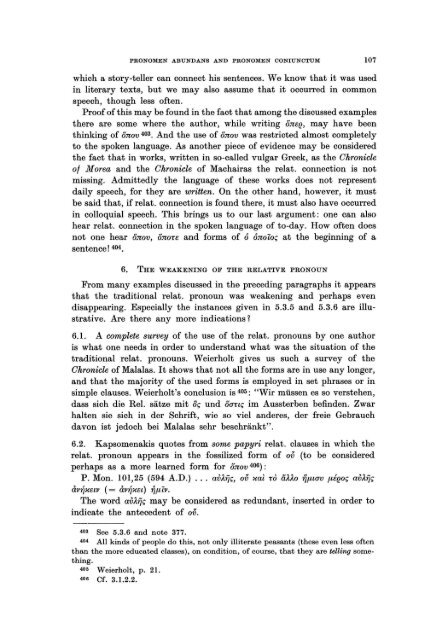Pronomen Abundans and Pronomen Coniunctum. A ... - DWC
Pronomen Abundans and Pronomen Coniunctum. A ... - DWC
Pronomen Abundans and Pronomen Coniunctum. A ... - DWC
Create successful ePaper yourself
Turn your PDF publications into a flip-book with our unique Google optimized e-Paper software.
PRONOMEN ABUNDANS AND PRONOMEN CONIUNCTUM 107<br />
which a story-teller can connect his sentences. We know that it was used<br />
in literary texts, but we mayalso assume that it occurred in common<br />
speech, though less of ten.<br />
Proof of this may be found in the fact that among the discussed examples<br />
there are some where the author, while writing one,!, may have been<br />
thinking of onov 403. And the use of onov was restricted almost completely<br />
to the spoken language. As another piece of evidence may be considered<br />
the fa ct that in works, written in so-called vulgar Greek, as the Chronicle<br />
ol M orea <strong>and</strong> the Chronicle of Machairas the relat. connection is not<br />
missing. Admittedly the language of these works does not represent<br />
daily speech, for they are written. On the other h<strong>and</strong>, however, it must<br />
be said that, if relat. connection is found there, it must also have occurred<br />
in colloquial speech. This brings us to our last argument: one can also<br />
hear relat. connection in the spoken language of to-day. How of ten does<br />
not one hear onov, ono7:8 <strong>and</strong> forms of ó ónotoç at the beginning of a<br />
sentence! 404.<br />
6. THE WEAKENING OF THE RELATIVE PRONOUN<br />
From many examples discussed in the preceding paragraphs it appears<br />
that the traditional relat. pronoun was weakening <strong>and</strong> perhaps even<br />
disappearing. Especially the instanees given in 5.3.5 <strong>and</strong> 5.3.6 are illustrative.<br />
Are there any more indications?<br />
6.1. A complete survey of the use of the relat. pronouns by one author<br />
is what one needs in order to underst<strong>and</strong> what was the situation of the<br />
traditional relat. pronouns. Weierholt gives us such a survey of the<br />
Chronicle of Malalas. It shows that not all the forms are in use any longer,<br />
<strong>and</strong> that the majority of the used forms is employed in set phrases or in<br />
simp Ie clauses. Weierholt's conclusion is 405: "Wir müssen es so verste hen ,<br />
dass sich die Rel. sätze mit öç und oanç im Aussterben befinden. Zwar<br />
halten sie sich in der Schrift, wie so viel <strong>and</strong>eres, der freie Gebrauch<br />
davon ist jedoch bei Malalas sehr beschränkt".<br />
6.2. Kapsomenakis quotes from some papyri relat. clauses in which the<br />
relat. pronoun appears in the fossilized form of ov (to be considered<br />
perhaps as a more learned form for onov 406) :<br />
P. Mon. 101,25 (594 A.D.) ... aVÀijç, ov xat rà aÀÀo fjfllav fléeoç aVÀijç<br />
àv~xelv (= àv~x8l) ijfliv.<br />
The word avÀijç may be considered as redundant, inserted in order to<br />
indicate the antecedent of ov.<br />
403 See 5.3.6 <strong>and</strong> note 377.<br />
404 All kinds of people do this, not only illiterate peasants (these even less of ten<br />
than the more educated classes), on condition, of course, that they are telling something.<br />
405 Weierholt, p . 2l.<br />
406 Cf. 3.1.2.2.
















